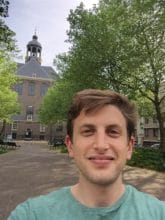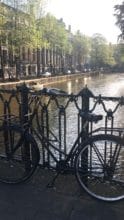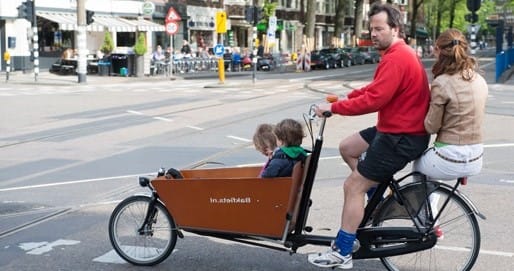Scenario 1: Biking to work in Washington, D.C.
I leave the house, heading west. Soon I encounter Georgia Avenue, one of the highest-capacity roads in Washington D.C. As I wait for the light to change, as many as a hundred cars thunder past me—they’re bumper to bumper, flying by at nearly 40 miles per hour. Once my light turns green, I pedal southwest to 11th street, where I can enjoy a “separate lane,” a strip of white paint that suggests where drivers should yield to cyclists. The street is also a bus route, so bikers are forced to merge into heavy traffic as buses pick up and drop off their passengers. After continuing southwest for some time, I turn onto the commercial strip of 17th street. Here, I dodge and weave through trucks and deliverymen as they unload their wares into the restaurants nearby. My ride ends with a few hundred meters on the chaos that is Massachusetts Avenue, another one of D.C.’s busiest thoroughfares.
The overall experience: Enjoyable, in an adrenaline-fueled, hectic sort of way. Not particularly safe. Worth it, but it’s clearly not for everyone.
Scenario 2: Biking to work in Amsterdam.
My  ride starts with a few hundred meters on a pedestrian- and cyclist-only path bordering a park. I soon turn right onto Czar Peterstraat, a route that has one lane for cars going north, two lanes for electric trams, and two wide bike lanes. Every transportation grade is separated by a hefty concrete barrier. After crossing one mid-sized intersection, I’m cruising down Sarphatistraat, wheel-to-wheel and handlebar-to-handlebar with dozens of other bike commuters. The ride is almost eerily quiet—other than the low rumble of the electric trams and the occasional car or motorcycle, the only noises are the gentle ringing of bicycle bells and commuters talking to one another. I cut west on Plantage Middenlaan. It’s a higher capacity road but bikers still enjoy a separate transportation grade, along with a view of the flamingos at the Royal Zoo. I cut through a small park—no cars allowed, obviously—push myself over another canal, and eventually I’ve arrived at my office.
ride starts with a few hundred meters on a pedestrian- and cyclist-only path bordering a park. I soon turn right onto Czar Peterstraat, a route that has one lane for cars going north, two lanes for electric trams, and two wide bike lanes. Every transportation grade is separated by a hefty concrete barrier. After crossing one mid-sized intersection, I’m cruising down Sarphatistraat, wheel-to-wheel and handlebar-to-handlebar with dozens of other bike commuters. The ride is almost eerily quiet—other than the low rumble of the electric trams and the occasional car or motorcycle, the only noises are the gentle ringing of bicycle bells and commuters talking to one another. I cut west on Plantage Middenlaan. It’s a higher capacity road but bikers still enjoy a separate transportation grade, along with a view of the flamingos at the Royal Zoo. I cut through a small park—no cars allowed, obviously—push myself over another canal, and eventually I’ve arrived at my office.
The overall experience: Serene. Totally safe, as long as you keep an eye out for your fellow cyclists. Perhaps most notably, everyone takes part—the people riding alongside me are schoolchildren, businessmen in suits, hippies wearing tie-dye, Muslim women in headscarves, young couples holding hands, etc.
We seldom think about it, but the way we get around profoundly influences how we experience cities. To get into a car is to enter a sort of bubble—you close the door, turn on the stereo, and are separated from the rest of the world by a thick windshield and about 1,000 kilograms of metal. Using public transportation also has a way of sealing you off. On a bus or a tram, sit down, put on your headphones, and watch the city go by. On a subway, you go underground in one part of town and pop out in another, experiencing none of the urban landscape in between.
Biking, on the other hand, allows you to interact with the city as a seamless whole. Nothing separates you from your environment. You experience the weather head-on. You can hear the conversations people are having on the sidewalk. You can speak to other bikers at the traffic light. You develop an intimate knowledge of the streets—you find yourself subconsciously avoiding familiar potholes, recognizing slight changes in slope, and speeding up to catch a quick light.
Finally, biking is fun. There is something innately enjoyable about pushing yourself around on two wheels, going wherever you want at whatever speed you feel like. It’s nothing short of liberating. Drivers and mass transit commuters during rush hour—are you feeling liberated?
Obviously, it’s not really fair to compare any American city’s cycling infrastructure to Amsterdam’s. By American standards, D.C. has actually done quite well for its cyclists. But living in Amsterdam is a constant and tantalizing reminder of the possibilities that exist when you reduce the role that cars play in the planning equation.
Here’s hoping that my generation of urban dwellers will drop the “from my cold, dead hands” attitude about cars in cities, and give bicycles the priority they deserve.
Ross Tilchin is a visiting fellow at the Amsterdam Institute for Social Science Research and a member of the strategy team at the Amsterdam Economic Board. Before arriving in Amsterdam, Ross worked as a researcher at the Brookings Institution, a nonprofit research organization in Washington, D.C., where he specialized in urban economic development and a wide range of issues related to cities. You can read his previous blog here.
